51st Evacuation Hospital Unit History
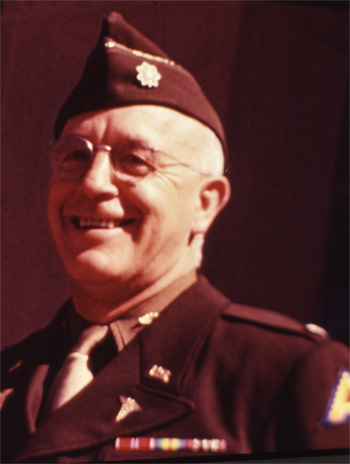
Lieutenant Colonel Orrin S. Cook, founding member of the 51st Evacuation Hospital.
Introduction & Activation:
The 51st Evacuation Hospital was the brainchild of WW1 veteran Dr. Orrin S. Cook. Cook had worked as the head of the Radiology Department at Mercy General Hospital, Sacramento, California during the interbellum years, and early in 1942 Cook wrote to the US Army Medical Department and officially requested permission to form a Sacramento County-affiliated field hospital. Permission was eventually granted in September 1942 by Colonel William E. Shamborra (later to become Chief Surgeon, Army Ground Forces -ed) in Washington D.C., and throughout September a constant stream of volunteers for the new unit were given direct commissions, and assigned to Temporary Duty at Fort Ord, Monterey, California while the formal activation of the unit took place.
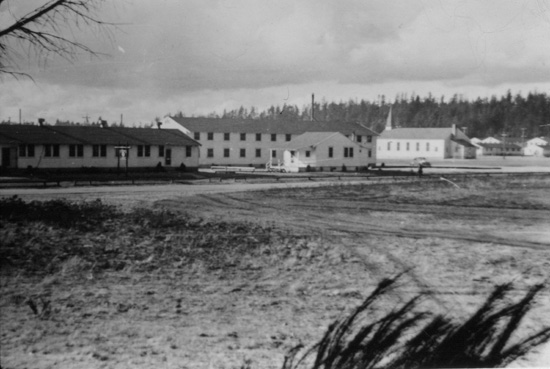
General view showing the barracks at Ft. Lewis, Washington, the first home of the 51st Evacuation Hospital.
Activation of the 51st was eventually completed in the latter half of September 1942, and the unit was officially mobilized at Fort Lewis, Tacoma, Washington (Army Ground Forces Training Center, total acreage 90,870, troop capacity 3,542 Officers & 63,727 Enlisted Men –ed) as a 750-bed Evacuation Hospital (the 51st was the last of the Evacuation Hospitals to be mobilized as 750-bed units, all subsequent Evacuation Hospitals were assigned as 400-bed units –ed). The Hospital’s first Commanding Officer was Colonel Wendell A. Weller who had previously served as a Medical Officer at the Lederman General Hospital in San Francisco. At the time of activation, the 51st consisted of:
32 Medical Officers
3 Dental Officers
5 Medical Administrative Officers
2 Chaplains
52 Nurses
1 Hospital Dietician
318 Enlisted Men
Training:
The next few months saw additional Enlisted Men and Officers joining the unit in order to complete the Table of Organization. During this period, all of the Nurses and some groups of Officers were assigned to the Ft. Lewis Station Hospital. Training was also introduced for the remainder of the enlisted cadre, and included 5-mile hikes, training in the use of gas masks, and several night maneuvers (some in sub-zero temperatures).
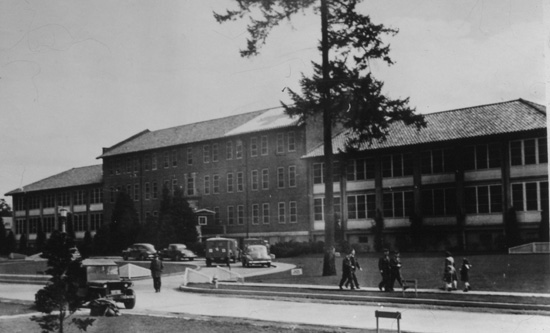
Exterior view of the Station Hospital at Ft. Lewis. Officers and Nurses of the 51st were assigned to duty here, and numerous training programs implemented.
By March 1943, the Hospital’s personnel had progressed well and showed very positive signs of becoming a strong and confident unit. Orders were received later that month for the unit to move from its current station at Ft. Lewis to the Desert Training Center (DTC – ed) established in the Mojave Desert, California. The assignment was to provide medical care to the numerous Armored Divisions in training at this location.
An advance party left a few days before the balance of the unit via motor convoy, to prepare the site for the impending arrival of the unit’s equipment. The party included the Commanding Officer, as well as several senior medical Officers. The remainder of the unit travelled by railroad to the DTC, accompanied by their bedrolls and footlockers a few days later, arriving at Goffs, California in April 1943.
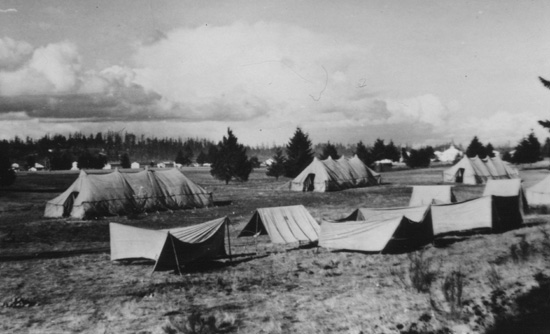
Tents belonging to the 51st erected during one of the many field maneuvers carried out by the unit during its time at Ft. Lewis.
Alongside the normal operating procedure of an Evacuation Hospital, the 51st also used the time to further develop its skills in the field. The program for the personnel was largely tailored around the hot days and cold nights often experienced in the Mojave; the morning began with calisthenics, followed by a breakfast of canned or dehydrated “B” Rations after which Col. Weller issued the day’s orders.
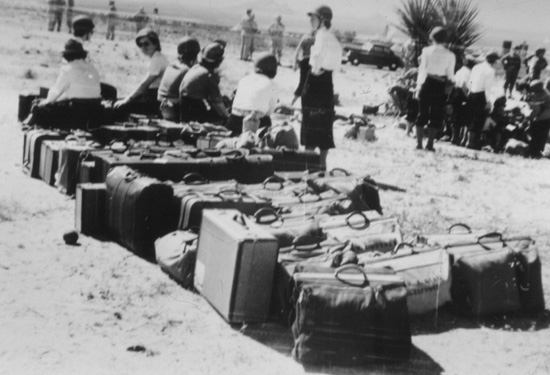
Nurses of the 51st wait patiently with their personal belongings upon arrival at the Desert Training Center in the Mojave Desert, California.
A handful of patients were received that required treatment for injuries and wounds sustained during the Armored Division training in the area (including burns, lacerations and broken bones), but the vast majority of the 51st’s wards were filled with patients that had developed “desert appendicitis”– soldiers with signs and symptoms suggesting appendicitis, but which cleared with a liter or two of IV saline, as well as patients whose pilonidal sinuses had become symptomatic from being bumped and chafed in tanks and other armored vehicles.
During the maneuvers in the desert, all personnel were limited to a single canteen of water per day.
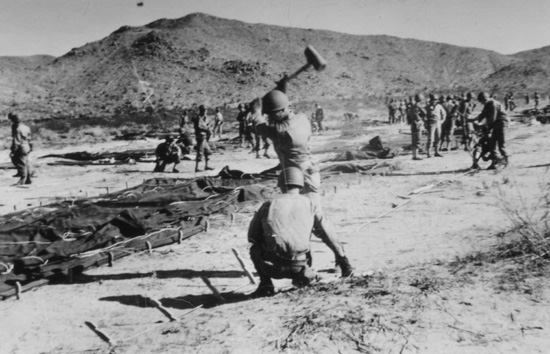
Personnel of the unit begin pitching Hospital Ward Tents and driving in the numerous pins required.
Facilities around the camp continued to be improved, with running showers soon proving to be a welcome addition in the midday heat of the Mojave Desert. A large amount of gravel had been sourced from the nearby Colorado River, and was transported in trucks to the 51st’s location. The gravel was then used to prepare concrete floors for both the Ward Tents and the personnel quarters, allowing better housekeeping and sanitation in the dusty conditions.
Boxing matches and softball games were frequently organized between the 51st Evac Hosp personnel and neighboring units. USO shows were also occasionally staged, some attracting large and popular stars including Les Brown and his “Band of Renown”.

Hospital personnel mix cement and prepare solid bases for the Small Wall Tents being used as quarters for the 51st’s staff.
In early May 1943, the unit received orders to move to the Desert Training Center Headquarters in Banning, California, where it was to begin operating as a 1,000-bed Provisional General Hospital. For approximately 4 weeks, the unit was divided into two, with Lt. Col. Cook assuming command of the unit remaining behind in Goffs until a replacement hospital unit could be located and established. An advance party moved by truck to Banning, in order to begin the preparations for the new setup.
The selected location was a freshly-mown oat field on the outskirts of the town. Jeep-drawn hay rakes were used to clear stubble from the field and slowly tents were pitched. The new 1,000-bed complex soon began to take shape. Within only a matter of days of opening, the unit received its first patients; 3 wards were filled with chronic venereal disease patients, while the remainder of the hospital was used for the issuing and validation of Certificate of Disability Discharge patients (CCD).
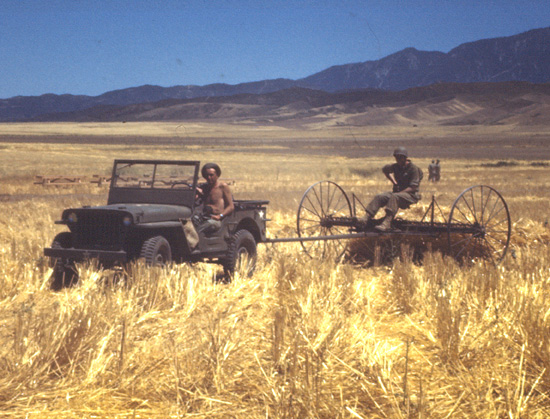
A 1/4-ton Truck of the 51st tows a large hay rake, which was used to clear the long stubble which covered the new site at Banning, California.
The 51st received a Mobile Surgical Unit while stationed in Banning, which comprised two Operating Room Trailers and two additional trailers for central supply and sterilization. The unit soon proved to be too small and crowded to be efficient, and so was never officially adopted by the 51st.
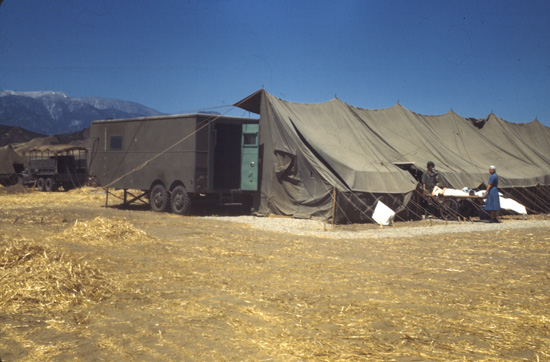
Illustration showing the Mobile Surgical Unit assigned to the 51st Evacuation Hospital while stationed at Banning.
Additional orders were received in December 1943 for the personnel of the 51st Evacuation Hospital to begin preparations in order to once again move the unit and its equipment to Camp San Luis Obispo, California (Infantry Division Camp, total acreage 15,433, troop capacity 1,523 Officers & 19,383 Enlisted Men –ed). The unit was relieved by the 97th General Hospital.
Upon arrival at the new station, many of the personnel couldn’t believe their luck! Gone were the unpleasantly hot and dusty conditions of the Mojave. Instead, the personnel were housed in tar-paper huts. This wasn’t the only perk, class “A” rations were also provided; fresh eggs, milk, meat and vegetables were a welcome treat.
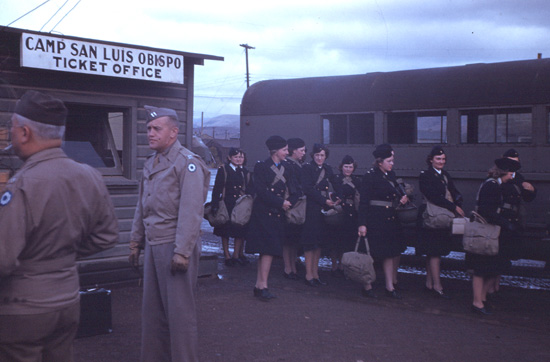
Members of the 51st Evacuation Hospital arrive at the railroad station at Camp San Luis Obispo, December 1943.
During the stay at Cp. San Luis Obispo, all of the unit’s Nurses were marched to work in the Station Hospital, while the Officers and Enlisted Men took a series of 5-mile training hikes in preparation for mobilization. In addition, simulated aerial attacks were co-ordinated to provide further training to the unit’s personnel. An artillery spotting plane was ‘borrowed’ from the 81st Infantry Division (also stationed in the camp), and brown paper bags were filled with flour, and dropped from the aircraft by Capt. Elbert T. Rulison.
Further training and psychological conditioning was also received during this period. All personnel received instructions in map-reading and terrain navigation, while some were also selected to take a course on mines, booby traps and demolition.
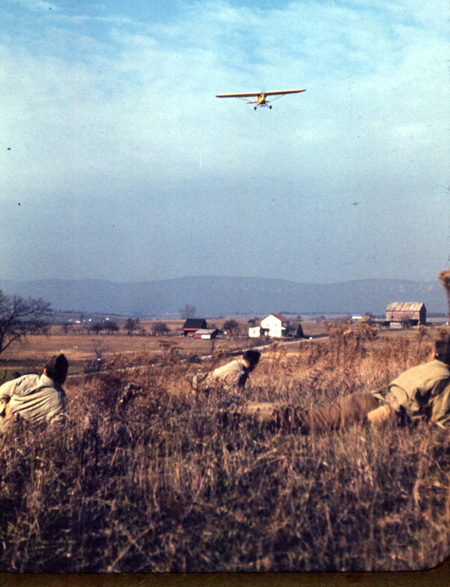
An artillery spotter aircraft carrying Capt. Rulison armed with his ‘flour bombs’ strafes 51st Evac Hosp personnel.
At Camp San Luis Obispo the Medical Officers of the 51st were interviewed by a colonel from the Inspector General’s Department to gauge their impression of Col. Weller’s command ability. There were serious consequences from these interviews, for they were set-up by Col. Weller himself to identify and eliminate all Officers who expressed any dissatisfaction with his command.
After the unit moved to Camp Cooke, Oceano, California, Col. Weller sent Lt. Cols McNeil and Cook to the Mayo Clinic for a training program, and in their absence, he had orders drawn up transferring out to other units all medical officers the Inspector General Colonel had identified as undesirable. Before leaving for Camp Cooke with the rest of the unit in January 1944, Capt. Rulison was able to contact Lt. Col. Cook and notified him of the ordered transfers. Lt. Col. Cook immediately telephoned Col. Shamborra in Washington, D.C., and Col. Shamborra promptly rescinded Col. Weller’s orders. With the help of the California Highway Patrol, the Officers en route to their new assignments were intercepted and returned to Camp Cooke.
Preparation for Overseas Movement:
Camp Cooke, Oceano, California (Division Camp, total acreage 88,803, troop capacity 2,346 Officers & 35,288 Enlisted Men –ed) was the assigned Staging Area for the 51st Evac, while it awaited further orders for overseas movement. At this time, the 43 Officers, 50 Nurses and 243 Enlisted Men of the Hospital made final preparations for their move out of the Zone of Interior. Personnel photographs were also prepared, and final training sessions were held for all staff members.
The unit departed from Camp Cooke by railroad in early March 1944. A cross-country journey was then made to Camp Patrick Henry, Oriana, Virginia (Staging Area for the Hampton Roads Port of Embarkation -ed).

Officers of the 51st Evacuation Hospital assemble at Camp Cooke, California and await transport to Camp Patrick Henry, Virginia.
Upon arrival at Cp. Patrick Henry, the unit then boarded a Liberty Ship at Hampton Roads, Virginia which would eventually transport them as part of a 115-ship convoy to Oran, Algeria. The trip lasted a total of 23 days. Five days into the voyage, the ship’s refrigeration failed, and all of the fresh food had to be thrown overboard. Fortunately, some of the passengers and crew had experience with Army mess duty, and were able to bake fresh bread.
Algeria:
19 April 1944, after debarking from the Liberty Ship and collecting all personnel belongings, the unit’s Officers and Enlisted Men were transported to a large vineyard in an area just outside of Oran, Algeria. Tents and other items of the Hospital’s equipment were prepared, and a bivouac area established. The Nurses of the 51st were stationed in houses on the other side of Oran (Ain-el-Turk), which represented a long truck journey from the actual hospital location.
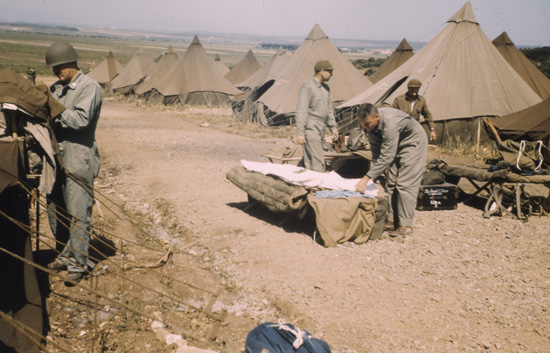
Hospital personnel prepare their individual equipment for the stay near Oran. The area was referred to by the staff as “Goat Hill”.
The 51st had been in the Oran area for only about two months and almost without a real job when it received new orders for a transfer to Italy. During the first week of June, a Hospital Ship (the USAHS “Seminole” –ed) arrived to transport the unit to its new station in Naples, Italy.
Italy:
The journey was completed on 5 June 1944, and the unit debarked to the news that Rome had been liberated the day before. The initial bivouac area was in the grounds of the Summer Royal Palace at Fusaro, a village on the north tip of the Bay of Naples. Shortly after arrival however, all the unit’s Officers and Nurses received Temporary Duty Orders, assigning them to various hospital units in Italy, from Battipaglia all the way to Rome. These assignments would last for the next 2 ½ months. The assignments included the 21st General Hospital in Naples, which formed part of a larger complex of US Army Hospitals occupying the elaborate buildings of the Fair Grounds, Naples.
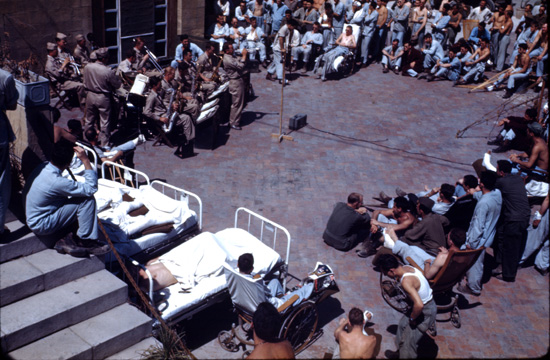
Patients of the 51st Evacuation Hospital enjoy a USO Show organized at the Summer Royal Palace, Fusaro, Italy.
A constant stream of battle casualties was received at all Hospitals, but the retreat to the north by the German Army following the liberation of Rome, saw the numbers decrease significantly. This provided the personnel of the 51st some time to explore the countryside and regular tourist resorts of Italy, including Naples, Pompeii, Sorrento and Capri.
All Temporary Duty assignments came to an end on 11 August when the unit assembled to start boarding for their next operation. The organization was to become part of the largest convoy to depart the restored docks in the Naples area and sail for the R-V point between the northwestern coast of Corsica and the landing beaches in southern France. On 15 August 1944, the 51st Evacuation Hospital received orders to be the first hospital landed as part of the invasion of Southern France (Operation “Dragoon” –ed). For the invasion, the Hospital was divided into 3 separate units. Each section was transported in LCIs (Landing Craft Infantry –ed) from Pozzuoli (near Naples) to the landing beach at Saint-Tropez, France.
France:
The 51st arrived in Saint-Tropez on 18 August 1944 (D+3), and began the journey inland to Draguignan, where the Hospital was to be established.
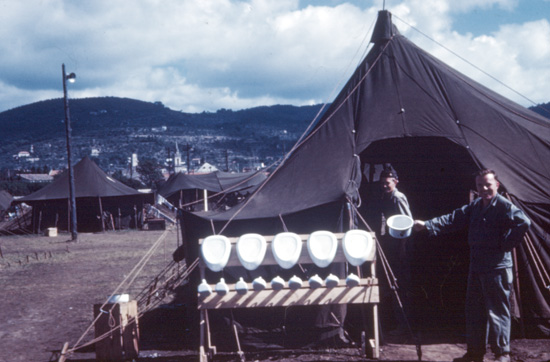
Bed pans and other utensils could be dried in the Italian sun.
The first unit, under the command of Lt. Col. Douglas Scott (Executive Officer of the 51st Evac Hosp), consisted of surgical teams assembled from a number of different hospitals, and was the first of three sections to land with the invasion. Upon arrival in Draguignan, the unit set up a small hospital in buildings which had previously been used by German medical troops. This represented the 51st’s first experience of handling actual battle casualties in any serious numbers. There was a very steep learning curve for the majority of the Hospital’s personnel, and initial treatments by the first hospital unit had been so poor, that the US Army contemplated breaking up the 51st Evacuation Hospital!
The 51st Evac was to stay in Draguignan from 27 August to 20 September 1944. The bulk of admissions were members of the 1st Airborne Task Force. Due to the large incoming flow of wounded and their personnel limitations, 18 Officers, 1 Nurse, and 19 Technicians from other units were temporarily attached to the 51st.
However, as the weeks passed, the setup became more comfortable for all, and the quality of care provided to the Hospital’s patients improved. The front lines moved rapidly up the Rhône Valley (to the north) and over to the Italian border at Menton; the latter proving to be a stalemate lasting until the end of the war in Europe.
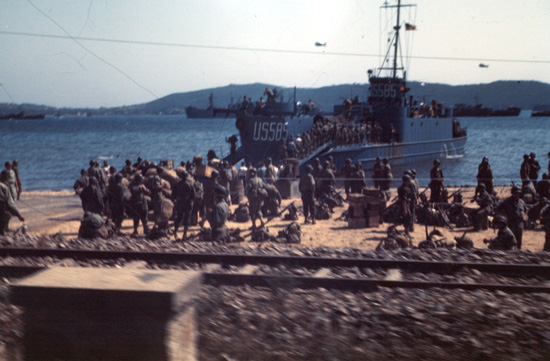
Staff debark from one of several LCIs used to transport the 51st Evacuation Hospital to France. Saint-Tropez, August 1944.
As admissions fell, there was more time for the unit’s staff to explore the local area, and become familiar with their surroundings which, up until this point, had not been investigated. The streets were still full of French Resistance members, and across town the heads of women accused of collaborating with the German occupiers were shaved. In the vineyards around the hospital facility were the remains of the gliders from the invasion fleet, and German coastal defences along the Côte d’Azur were very evident and prominent landmarks.
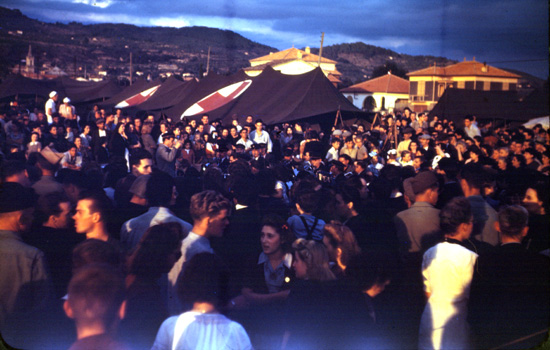
Local inhabitants visit the facility at Draguignan, September 1944.
On 29 September 1944, after a month of operations in Draguignan, orders were received for the 51st Evacuation Hospital to be transferred to central France, in support of the United States Seventh Army. During this period, a total of 2,007 patients were admitted to the organization.
The long journey was made via rail, with Officers and Enlisted Men being loaded into 40 & 8 box cars, and Nurses into third class coaches. The journey was slow, and littered with delays, but after a week, the unit arrived in Epinal in the middle of the night. After detraining, all personnel, along with the hospital’s necessary equipment were transferred to trucks under blackout conditions, and began a further journey north east to the Lunéville area.
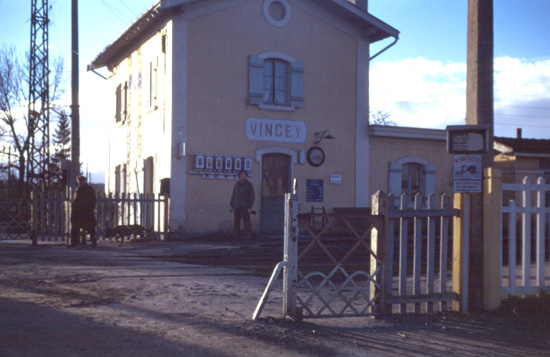
General view of the main booking office at Vincey Station, 11 October 1944.
On 11 October 1944, the 51st arrived in Vincey, a small village on the Moselle River. The location selected for the Hospital was a large open field which quickly turned into a swamp following floods of rain in the weeks leading up to the unit’s arrival. The conditions in Vincey were far from ideal. Without tent stoves, and with the surgeons required to carry out operations in long, narrow Ward Tents, as well as the assignment of the triage / pre-operative teams on a rotating basis, the cold, inconvenience and inexperience quickly resulted in a mounting backlog of surgical cases at the facility. Finally, tent stoves were sourced, making a huge difference to the surgical teams. There was no longer a need for field coats or hot water bottles to vaporize ether. The Commanding Officer also allowed the Ward Tents being used as operating rooms to be pitched side-by-side, and the walls raised, thus creating a large square operating theater with easy access to all of the operating tables.
One team consisting of Charlie Soracco, Andy Henderson and Don Jones, assumed control of the triage and pre-operative sections, ensuring that patients arrived in the O.R. adequately resuscitated with IV fluids and blood, with proper X-rays and sufficient blood to get them through their operations.
With these improvements, the backlog was finally cleared.

Due to heavy rainfall prior to its arrival, the 51st was severely hampered by the swamp that soon developed on the site at Vincey.
The 51st remained in Vincey until the end of November 1944, when further instructions were received to transfer to Saint-Dié-des-Vosges. The move was completed on 28 November 1944.
The city had been badly damaged by the battle for its liberation earlier in the year, but the 51st had been instructed to establish a functioning hospital in an undamaged caserne on the outskirts of the borough, which previously had been used for the quartering of French troops manning the Maginot Line. Since the unit was the closest hospital to the front line, all of the staff were kept immediately busy with a constant stream of patients being received.
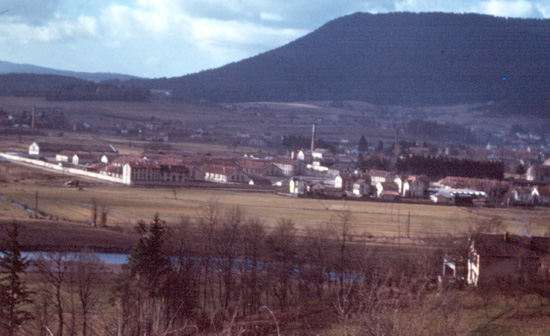
General view of the largely undamaged caserne used by the 51st Evacuation Hospital on the outskirts of Saint-Dié-des-Vosges.
Throughout the winter, the hospital received even more casualties than it had before. A winter campaign in the Vosges Mountains was launched in an attempt to push the German Army out of the Colmar Pocket and back across the Rhine. The fighting was intense, and at times only the most seriously wounded were unloaded from ambulances at the facility due to a severe lack of ward space. The remainder were transported to either the 59th Evacuation Hospital, or the 23d Evacuation Hospital, both of which were established further behind the lines.
Serious wounds, such as head or maxillo-facial injuries, thoraco-abdominal wounds, compound fractures and multiple shrapnel wounds, required extended operating time, often with multiple surgical teams. Freezing temperatures and snow added to the difficulties, and the unit required constant crews to clear snow from the large Geneva Convention markers scattered around the facility, and adorning the Ward Tents.
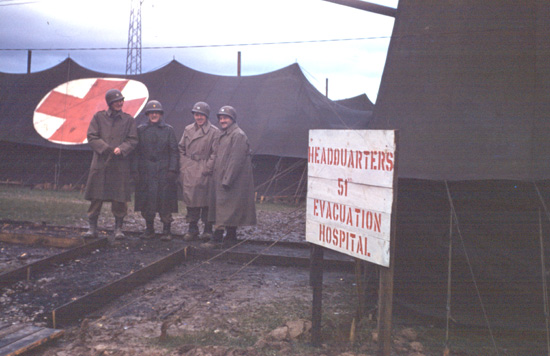
Officers of the 51st Evacuation Hospital stand in front of the unit’s Headquarters, before leaving for Epinal.
Finally, by February 1945 the German counterattack was successfully pushed back across the Rhine River. The casualties immediately began to dwindle, and the 51st Evacuation Hospital’s staff took the opportunity to relax and explore their surroundings, which had received severe battle damage during the winter campaign.
The facility was finally closed on 14 March 1945, orders were received to strike all tents and prepare the unit for transit to yet another location in north-eastern France (Alsace region -ed) – Sarre-Union.
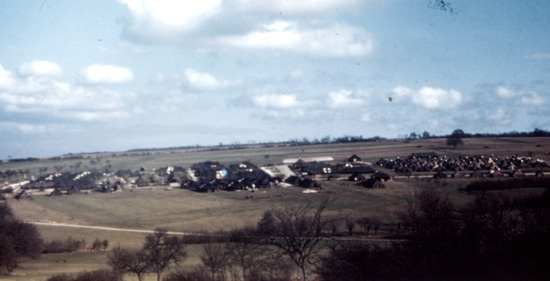
Aerial view of the tented facility established at Sarre-Union.
The 51st arrived in Sarre-Union the following day, and immediately began to establish a tented facility in a field outside of the town. Two or three operating rooms were continually treating US troops who had stood on wooden Schu-mines, usually severely damaging or disfiguring both feet. A number of civilian casualties were also received.
After only 10 days of operation, further orders were received by the unit’s Chief of Surgery, Lt. Col. McNeil for yet another change of station on 24 March 1945.
Germany:
After the Allied troops had crossed the Rhine, the 51st found itself moving into Germany, crossing the Siegfried Line in the process. The Hospital was to occupy a large ex-German military hospital in the city of Neustadt. After only a few days of operation however, the buildings were found to be largely unsuitable for the Hospital’s operation, and so the main collection of rooms was used for living quarters, while the wards, operating rooms and x-ray departments were moved to nearby garages and workshops. The stay here was short, and after only 4 days the 51st was once again on the move.
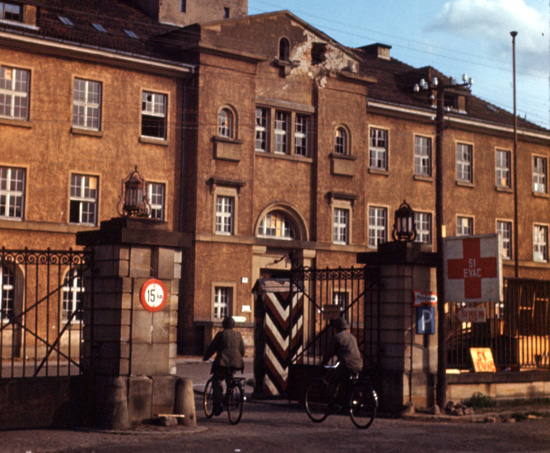
Entrance to the large German military hospital which was utilized by the 51st Evacuation Hospital.
The unit crossed the Rhine River on a floating bridge at Worms, and then travelled by road toward Nürnberg, finally reaching its destination of Walldürn on 4 April 1945. The Hospital was set up at the main intersection of the road to Heidelberg.
Some of the first patients to be received in this new location were freed British troops from the surrounding Prisoner of War camps.
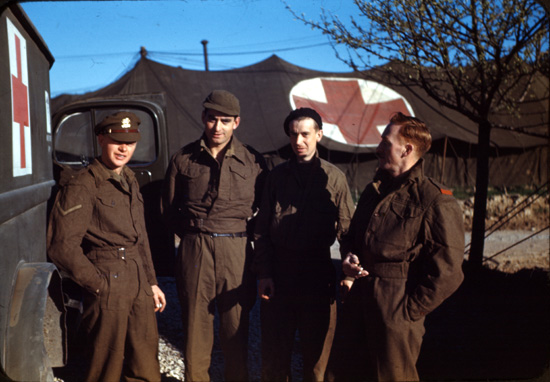
Liberated British PWs stand among the many Hospital Ward Tents of the 51st Evacuation Hospital.
Each night, a single German plane would fly over the facility and circle the hospital complex, firing on any vehicle which was travelling down the nearby road without blackout conditions. One night, a large truckload of German prisoners being transported to the rear was hit, which meant a busy night in surgery for the staff at the 51st!
Following the death of Franklin Delano Roosevelt, the 51st held a memorial service for the late President on 13 April 1945.
By 20 April 1945, admissions had gradually dwindled, and further orders were received to move the Hospital to Murrhardt. However, the front line was moving at such a pace that additional orders were received for the Hospital to move farther inland before the facility could be established. Three days later, the unit once again set up in a large clover field on the outskirts of the small town of Welzheim – this was to be the unit’s home for the next 3 months.
Around the site, captured German Army tents were put to use as Pre-Operative Wards, X-Ray and Surgery departments. The whole unit worked with more confidence and efficiency than ever before, yet the Commanding Officer was still displeased with the general performance of the unit. However, very few patients were received during this period.
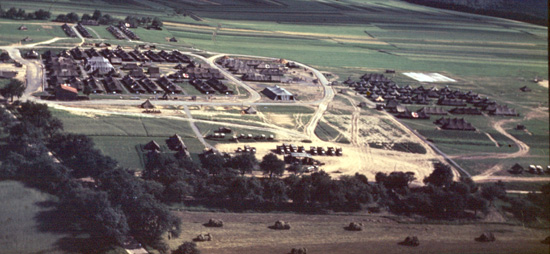
Aerial view of the tented hospital set up by the 51st Evac Hosp at Welzheim, Germany.
On 30 April 1945, the day after the liberation of Dachau Concentration Camp, Chaplain Godfrey and another member of the 51st were ordered to visit the camp. Captains Rulison and Wallace accompanied the two. Upon arrival at the camp, the group found the German guards lying dead in the streets, and the surviving prisoners confined to their compounds because of a typhus epidemic.
Following V E Day (8 May 1945), the 51st saw an increase in patient load, this time though, it was a completely different specimen of patient. Most of the admissions were for methyl alcohol poisoning, accidental gunshot wounds (typically from captured weapons) and vehicle accidents.
It was during this period that one member of the nursing staff of the 51st was killed when a Command Car in which she was travelling left the road on a bridge, pinning her underwater. This was the only overseas casualty suffered by the unit.
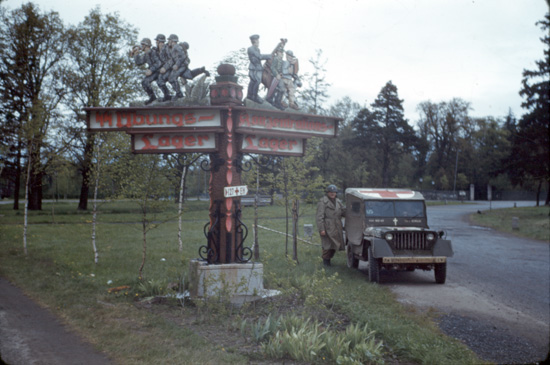
Chaplain Godfrey stands beside his 1/4-ton Truck en route to Dachau Concentration Camp.
Artillery spotter aircraft frequently landed on the hospital site, and provided interesting flights to some of the staff over Seventh Army controlled territory. Col. Weller and Chief Nurse Capt. Mabel Uhlmann granted permission for the wedding of Lt. Winona Webb and Capt. Alan Ford at the facility, with Chaplain Godfrey conducting the proceedings. Regular passes were issued, and the personnel took the opportunity to explore Germany, with visits to Hitler’s burned-out home at Berchtesgarten. In June, the unit was permitted to attend Jack Benny’s USO Show near Stuttgart, which included Ingrid Bergman, Larry Adler and Les Brown.

The happy couple! Lt. Winona Webb and Capt. Alan Ford shortly after their wedding ceremony at the 51st.
In July 1945 the unit began preparations to move to Stuttgart. The first of the Hospital’s Officers who had sufficient point scores received their orders for return to the Zone of Interior, and eventual discharge from the Army. The facility at Welzheim was finally closed on 20 July 1945, but at this time, the unit did not have any further orders!
The next few days were spent waiting for additional instructions, and these were finally received. The 51st was to move to Stuttgart, Germany.
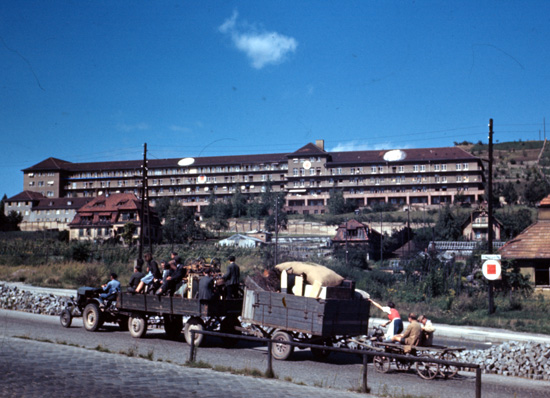
Exterior view of the Robert-Bosch-Krankenhaus, last station of the 51st Evacuation Hospital.
Upon arrival in Stuttgart on 17 August 1945, the Hospital was immediately set up in the upper floors of the Robert-Bosch-Krankenhaus on the outskirts of the heavily damaged city. The unit’s nursing staff were billeted in the nurses’ residence adjacent to the main hospital building. Very few patients were received during this period, and not long after arrival, Col. Weller was relieved of his command, and replaced by Colonel James Yarborough.

Col. Myron P. Rudolph (Seventh US Army Surgeon) presents Col. James Yarborough and Lt. Col. Orrin S. Cook with the Service Award of Merit for the 51st’s actions in the ETO.
On orders from the US Seventh Army, an official review of the 51st Evacuation Hospital was held on the grounds. Col. Rudolph presented Col. Yarborough and Lt. Col. Cook with the unit’s “Service Award of Merit”, citing the 51st’s record of 277 days of operation in the ETO, 21,666 patients admitted during that time, with 9,454 operations performed and 6,143 patients returned to duty.
The End:
The 51st Evacuation Hospital was finally relieved of duty on 12 October 1945, and ordered to return to the ZI for training and possible redeployment to the Pacific Theater of Operations. Any personnel with insufficient points to return home for redeployment were reassigned to the 216th General Hospital located across the river in Bad Canstadt.

Enterance to the 216th General Hospital, located in Bad Canstadt. Photograph taken October 1945.
When VJ Day arrived, all personnel were transferred to the embarkation point at Le Havre, and spent quite some time at Camp Lucky Strike while the backlog was cleared somewhat. The Nurses of the 51st Evac Hosp finally embarked for the US on 27 October 1945, aboard USS Hermitage, with the remainder of the personnel following a few days later.
Unit Roster:
Officers:
| Ankele, Cordes W. (Maj.) | Henderson, Andrew M., Jr. (Capt.) | Sabatino, Frank J. (Capt.) |
| Atkins, Joseph (Capt.) | Henstell, Philip (Capt.) | Saeltzer, Dudley V., Jr. (Maj.) |
| Cole, Edwin R. (Maj.) | Jones, Donald J. (Maj.) | Scott, Douglas G. (Lt. Col.) |
| Collins, Clyde A. (Capt.) | Kehrer, Howard W. (Capt.) | Smith, Arthur B. (Capt.) |
| Congdon, Russell S. (Capt.) | Lee, Frank W. (Capt.) | Soracco, Charles V. (Capt.) |
| Cook, Orrin S. (Lt. Col.) | Long, William (Capt.) | Stalker, Robert A. (Capt.) |
| Damerow, Wesley P. (Capt.) | Markham, Thomas H. (Chap.) | Stukenborg, Frank X. (Capt.) |
| Dettner, Robert W. (Lt. Col.) | McCabe, James J. (Capt.) | Taylor, Victor B. (Capt.) |
| Dufour, Kenneth I. (Capt.) | McDonnell, Curtis (Maj.) | Tucker, William H., Jr. (Capt.) |
| Eldredge, Edward F. (Capt.) | McNeil, Donald (Lt. Col.) | Von Der Ahe, Clyde V. (Capt.) |
| Ellsbury, Ronald R. (Maj.) | Noyes, Kenneth E. (Capt.) | Wallace, Arthur F. (Capt.) |
| Geraty, George M. (Maj.) | Palmer, John E. (Capt.) | Weddle, Robert P. (Capt.) |
| Godfrey, George D. (Chap.) | Prisinzano, Gandolfo A. (Capt.) | Weller, Wendell A. (Col.) |
| Harman, Thomas F. (Capt.) | Reinke, Arthur F. (Capt.) | Wilson, Albert C. (Capt.) |
| Harrington, John F. (Maj.) | Rosenthal, Milton (Capt.) | Yant, James H. (Maj.) |
| Harris, Stacy C. (CWO) | Rulison, Elbert T., Jr. (Capt.) | Yarborough, James (Col.) |

Officers of the 51st Evacuation Hospital.
Nurses:
| Amundson, Lorraine E. | Dulaney, Norma C. | Mensch, Cleta |
| Anderson, Hilda E. | Fellensen, Dallas | Michel, Louise A. |
| Arend, Leona | Forys, Minerva M. | Mitchell, Zetta |
| Badger, Mary | Gaynor, Margaret | Nereson, Myrtle N. |
| Ballow, Henrietta E. | Gregg, Stella O. | Ohlwein, Nola B. (ASN:N-737760) |
| Barber, Eleanor E. | Hall, Viola F. | Robb, Jane A. |
| Butler, Denta V. | Halvorsen, Helen L. | Seeley, Esther M. |
| Cavanaugh, Dorothy | Hansen, Julia A. | Smith, Doris |
| Chandler, Etta | Hendricks, Lauretta | Smith, Frances K. |
| Christian, Elsia T. | Kelly, Helen E. | Smith, Thelma J. |
| Christian, Isabel | King, Phyllis L. | Smithers, Florence R. |
| Cisne, Ida M. | Lear, Ellen J. | Sweetland, Raima A. |
| Cooper, Olga | Lindberg, Lelley E. | Thomas, Evelyn M. |
| Dailey, Virginia B. | Luntey, Leila | Uhlmann, Mable V. |
| Davey, Leona | Marshall, Lucile J. | Villamaria, Amelia |
| DeJacma, Dorothy | McCoppin, Margaret | Whitley, Lucille R. |

Nurses of the 51st Evacuation Hospital.
American Red Cross Workers:
| Dilworth, Dale (Staff Aide) | Ewing, Helen A. (Assistant Field Director) | Kantor, Florence (Secretary) |
Enlisted Men:
| Adkins, Chester A. | Greenbaum, Robert K. | Picard, Alfred |
| Adkins, Paul E. | Grosche, Wengort H. | Pobar, Charley |
| Akers, Raymond H. | Guilbeau, Levy P. | Pollard, Harry L. |
| Alexander, Walter J. | Guillory, Cliston T. | Przybylski, Peter P. |
| Allen, Cleve J. | Hakalmazian, George | Purdon, Walter F. |
| Alyea, Chester W. | Hall, Charles C. | Ralston, Arnold B. |
| Aragon, Jack | Hardin, Emmett L. | Randall, Bill R. |
| Ariaz, Arturo F. | Harris, Walter A. | Raynor, Jack O. |
| Armijo, Anastacio | Hart, Floyd L. | Redmon, William F. |
| Armijo, Raymond | Helgeson, Helmer C. | Reid, Steve |
| Armstrong, James L. | Helo, Henry | Reynolds, Ed F. |
| Arndt, Harvey W. | Hensley, George E. | Richey, Buster B. |
| Ashby, Edward W. | Herrera, Melchor Q. | Rivera, Rafael |
| Ault, Charles R. | Herrington, Johnnie V. | Rivoli, Henry J. |
| Baca, Cusebio Jr. | Herseth, Philip H. | Robertson, Woodson H. |
| Baeza, Samuel S. | Hesaltine, Charles E., Jr. | Rodgers, James J. |
| Bellville, Robert H. | Hicks, Arnet E. | Rodgers, Louis S., Jr. |
| Bennet, Robert H. | Hill, Clyde M. | Rodriguez, Robert A. |
| Bistes, Evans M. | Hill, Henry | Rose, Felix J. |
| Blaine, Edgar L. Jr. | Hillebrand, Earl V. | Roth, Herbert J. |
| Bobe, William | Hitchins, Joe G. | Runyan, James J. |
| Boiles, Andrew J. | Hitzke, Alvin W. | Rupper, Jarvis L. |
| Bostic, Lester C. | Hodges, Levy E. | Sanchez, Daniel |
| Bowling, William R. Jr. | Holfer, Omer C. | Sanders, Herman C. |
| Bowman, Joseph T. | Holland, Wilford D. | Schmidt, Edward F. |
| Bradley, Chester A. | Holmes, Gustave A. | Schneider, Hyman |
| Brady, Ralph A. | Horan, Claude D. | Schodowski, Walter S. |
| Branton, William H. | Hoton, Robert E. | Schoettler, Leroy J. |
| Bridgewater, Leland P. | Howell, J. D. | Schulz, Richard C. |
| Brunn, Henry H. | Hoyl, Wallace D. | Schumann, Floyd C. |
| Buckley, Elmo H. | Hudson, Alvin | Scott, Ralph E. |
| Bun, Roy W. | Human, D. F. | Sears, John L. |
| Buratovic, John F. | Humphreys, Rome B. | Seawright, Hugh |
| Burch, Harold R. | Hutcheson, Harlin J. | Sedler, Clarence H. |
| Burgthold, Charles R. | Jacobs, John B. | Selvage, Ezekiel H. |
| Burks, Richard B. | Jacobsen, Stanley M. | Serpico, John D. |
| Burrier, Troy R. | Kalinowski, Stanley M. | Seyller, Paul K. |
| Calus, David J. | Kallum, Dennis M. | Shackleford, William T. |
| Candejas, Salvador | Kapecki, Stephen J. | Siddle, Virgil H., Jr. |
| Cantor, Richard | Karczewski, Karl D. | Slay, Irvin L., Jr. |
| Caperton, J. | Keller, William B. | Sliwinski, Theodore W. |
| Cardenas, S. | Kendrick, Jack C. | Smidt, Alvin K. |
| Cardone, Michael J. | Kirk, Jack L. | Smith, James A. |
| Carpenter, William A. | Krueger, Roland E. | Smith, Jerome |
| Carrier, Ronald E. | Lambaren, Pascual Jr. | Solheim, Arthur E. |
| Carroll, James C. | Lang, Frederick | Speight, Roy F. |
| Carter, Rodger W. | Ledford, Clovis M. | Staples, David L. |
| Cash, Cecil G. | Ledoux, David | Stassi, Edward R. |
| Chantler, Herbert S. | Lewin, Siegbert S. | Stone, Jimmy C. |
| Cheek, Clarence N. | Lewis, Tom E. | Strickland, James E. |
| Cheek, Ova | Lokken, Lawrence E. | Stroberg, Allen R. |
| Cimellaro, Domenic | Long, Francis A. | Stuyvenberg, Warren J. |
| Claggett, Roscoe F. | Lopez, Haracio | Sumrall, Arvey L. |
| Clark, George J. | Lopez, Joe C. | Sunday, Vernon K. |
| Coats, Joyce J. | Luckett, Dwight | Surman, Walter F. |
| Coker, Harvey D. | Luke, Preston H. | Sutherland, Harland C. |
| Conner, Ernest | Lynch, Thomas H. | Swinson, Charles T., Jr. |
| Cooney, William E. | MacDonald, Stanley E. | Talley, Vallen L. |
| Cooper, Glen N. | MacMahon, William H. | Tanner, Lester W. |
| Cordes, Clifford E. | Makris, George J. | Taylor, Jack M. |
| Crider, Earl E. | Marcum, Cecil R. | Taylor, Vernon V. |
| Crouse, Jack W. | Marsh, Charley C. | Teetz, William A. |
| Daniel, Harold O. | Marshall, James T. | Thompson, Archie C. |
| Darby, Louis | Martinez, Elbert H. | Tolleson, Carrol N. |
| Davies, Jesse W. | Martinez, Forenzo C. | Tomaszewski, Robert A. |
| Davis, Lavern A. | Mascis, Murray J. | Trujillo, Frank F. |
| De La Rosa, Philip | Maxwell, Alvin M. | Turner, Densel C. |
| Decker, Lawrence E. | Maxwell, Travis L. | Tuttle, Jay K. |
| DeMonaco, Herman | Mayes, Harvey J. | Valdes, Rogolio S. |
| Deroy, Armand J. | McCook, John P. | Wagner, Raymond L. |
| Dobson, Geary O., Jr. | McCord, John C. | Waite, Kenneth M. |
| Domiter, Joseph A. | McCutcheon, Sophronous, H. | Walker, Thurman J. |
| Dover, Clyde O. | McFerron, Claude O. | Wallis, Robert B. |
| Dowling, Robert M. | McHughes, Milton P. | Wardenburg, Henry O., Jr. |
| DuRand, Clifford J. | McNulty, Maurice J. | Weikle, Howard F. |
| DuRand, Gustave A. | McPhillips, Jack H. | Weir, William S. |
| Englehart, Leland A. | Meineke, Otis E. | Wells, James W. |
| Ericson, David W. | Meyer, Leo | Weltman, Joseph J. |
| Erwin, Gene C. | Mihalik, John | Wendlant, Leonard R. |
| Espinoza, Leonardo O. | Montoya, Rafael P. | Westrum, Victor L. |
| Estrada, Salvador T. | Mora, Bonnie J. | White, Dewy D. |
| Eversole, Sam | Morehead, Ennis E. | Williams, Wallace N. |
| Farmer, Richard B., Jr. | Morrison, Stanley J. | Womack, Clinton R. |
| Felice, Joseph C. | Nelms, Lloyd J., Jr. | Wood, Charles W. |
| Ferrell, Jesse P. | Nelson, Homer T. | Wood, Paul E. |
| Flynn, Emmett J. | Newell, Robert S. | Wooten, Frank D. |
| Gallegos, Alex A. | Norman, Warren J. | Word, Jack L. |
| Glaze, Ovis V. | Norton, Lowell M. | Yaros, George, Jr. |
| Glynn, Leo W. | Norton, Raymond P. | Yee, Gene G. |
| Golden, David | Nunez, Formin L. | Yother, Joe L. |
| Gorwitz, Theodore H. | Oliver, Frank C. | Zahara, Edward W. |
| Gosnell, George M. | Padilla, Antonio J. | Zamora, John H. |
| Graham, Donald W. | Patkes, Joseph H. | Zavala, Agapito A. |
| Grand, Carl W. | Perkins, Herbert W. | Ziesenheme, George W. |

Unit photograph taken at Camp Cooke, California.
Operations – 51st Evacuation Hospital
Algeria – 14 April 1944 > 4 June 1944
Italy – 5 June 1944 > 11 August 1944
Southern & Central France – 18 August 1944 > 24 March 1945
Germany – 27 March 1945 > 12 October 1945
Campaign Awards – 51st Evacuation Hospital
Rome-Arno
Southern France
The MRC staff wish to express their sincere gratitude to Captain Elbert T. Rulison, Jr. (ASN:O-501764), who served with the 51st Evacuation Hospital during World War 2. Capt. Rulison kindly provided us with a full roster, as well as very detailed data and photographs relating to the unit’s service throughout the war. Capt. Rulison also published a detailed photo-story of his experiences with the 51st during WW2, and this can be found on the Rogue Publishing website.
